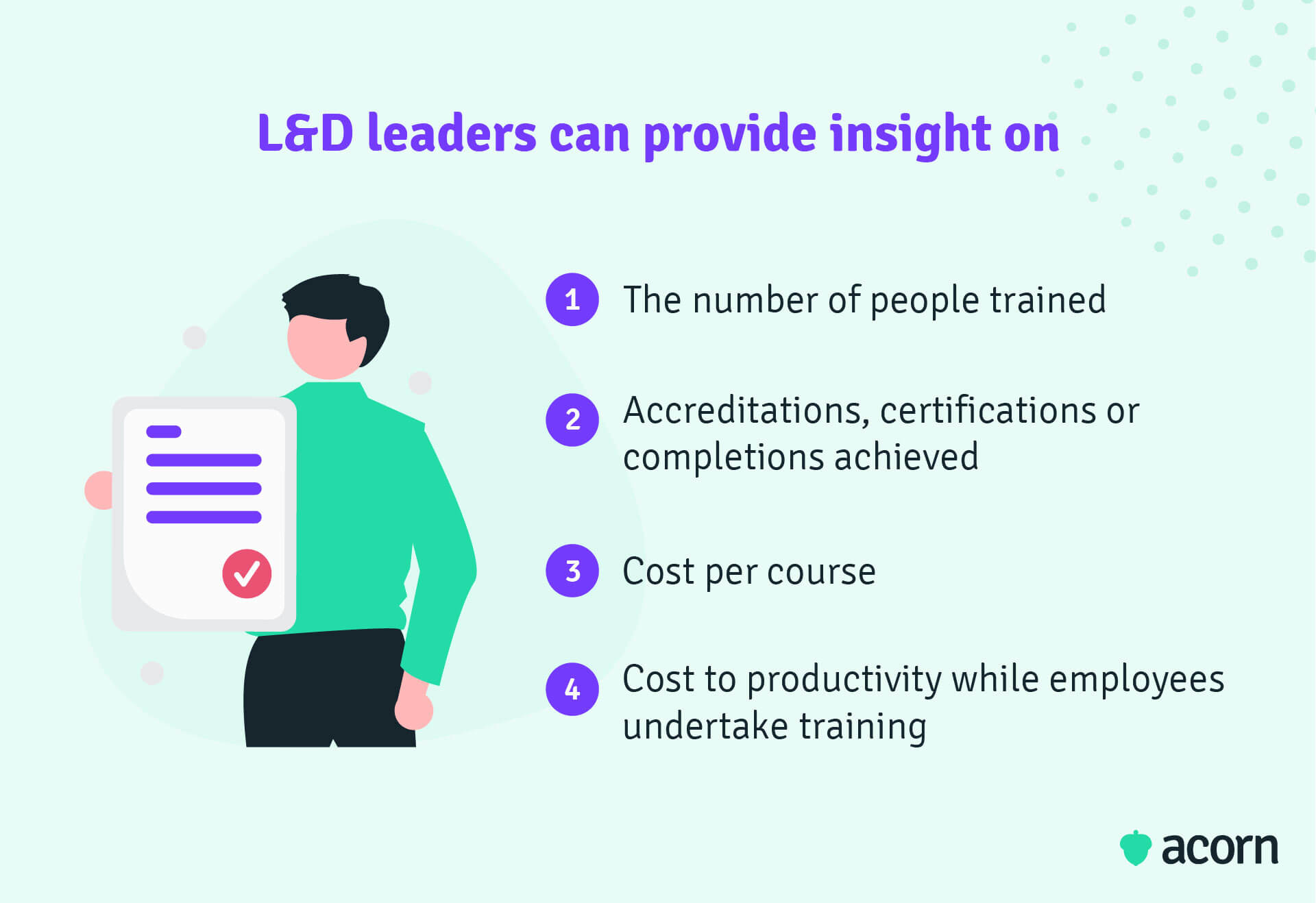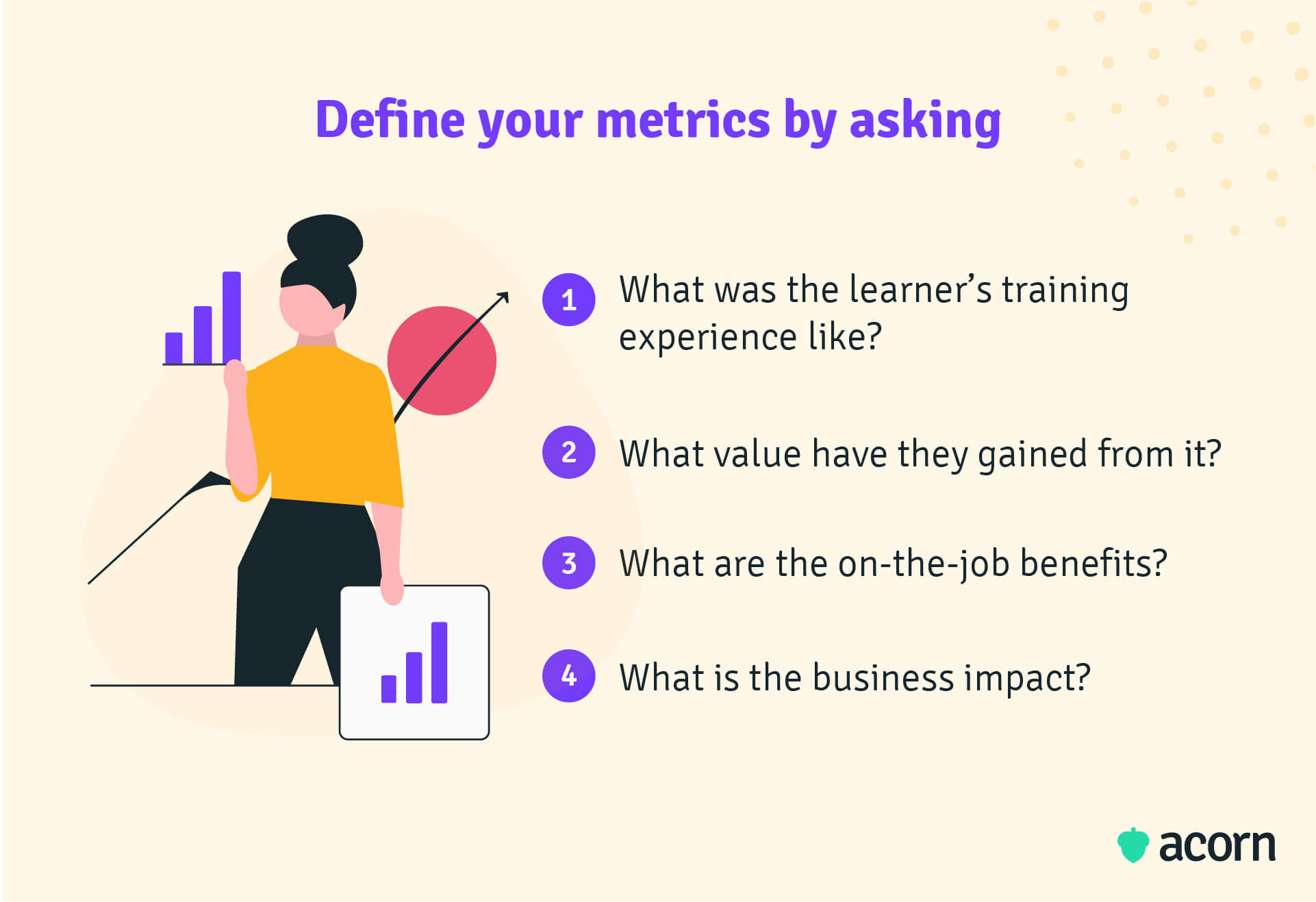Proving and Measuring Employee Training ROI

It can be and should be done – before, during and after training. Let us explain.
As with many of life’s necessities, employee training isn’t what you’d call cheap. Between the outlay for learning software and offsite training, and the potential productivity lags, there’s a lot riding on the investment.
And while calculating return on investment (ROI) is a little finicky, it’s incredibly important to ensure employee training is effective, business outcomes are positively impacted, and that you’re getting your money’s worth.
There are ways to go wrong here, so we’ll explain the importance and fundamentals of training ROI and how to get it right for your organisation in this blog.
Why calculate the ROI of employee training?
Simply put, ROI will show the business impact of any training program in monetary terms. It lets you know if your investment is or isn’t worth its salt based on the revenue or value it is generating for you.
But you know this. We’re not here to overexplain a concept you already understand in theory. Our point is to explain that, done right, ROI is the way to position L&D as a cost generator rather than a cost centre.
The first thing to understand is that ROI is not simply learner satisfaction or number of courses completed. We’re not saying to completely throw metrics like learner satisfaction or course completions out the window, because these are leading indicators that will inform the overall success of training. But we are saying you should be thinking as high level as you are lower order.
The second element to know is that by calculating the ROI of employee training, you’re understanding the business impacts in relation to costs. (Think: increased profit, money saved long-term and a competitive economic impact.)
Your training budget could be as low as a few hundred dollars, but for larger organisations it’s likely to break the tens (if not hundreds) of thousands. This’ll be determined against other budgetary requirements and how necessary you deem training and the method of delivery. An online learning management system, for example, is a large investment to make because the software needs ongoing maintenance, updates and upgrades. If you can’t demonstrate the results of that technology, there’s a chance training budgets could be diminished. The learning and development arm of your organisation might lose influence and resources. Interest in continuing training efforts may evaporate.
So, how can you be sure that the investment is worth it? By determining your ROI of training, of course. It’s not just about justification. It’s the ultimate measure of accountability.
BCR vs ROI
Many people tend to (rightfully) focus much of their energy on ROI, but your CFO may care more about BCR—so you need to be armed and ready. In most cases though, BCR and ROI are not interchangeable. They are two ways of understanding the financial benefits of an investment.
- BCR, or benefit-cost ratio, is simply the total benefits of training divided by the training costs.
- ROI is calculated by taking away the training program costs from the benefits to determine the true value gained.
In the case of training programs, the main difference is that BCR is a cost-benefit analysis that compares benefits to training costs, while ROI compares earnings (revenue, benefits, etc) against cost.
BCR appears as a ratio (BCR:1) while ROI is a percentage. So, ratios higher than one indicate a positive financial benefit, and anything equal to or less is a deficit. A BCR of 3:1 means that every $1 invested generates $3 in benefits. This could be translated to a ROI of 200%, wherein for every $1 invested, $1 is returned to the organisation and $1 is gained after costs are covered.
Do you really need to consider other measures?
It would be imprudent to assess ROI as its own beast or even the only measure worth utilising.
- Firstly, every department will have a different idea of what ‘success’, ‘failure’ and ‘benefits’ are, and thus, different ways of measuring them.
- Secondly, it would be a mistake to assume ROI is purely a measure of money made.
ROI is not the whole story. Reporting on other performance metrics is the best way to truly understand the impact of a training program because different facets of those programs will likely have differing impacts on your organisation and business outcomes.
If you assume each holds the same weight, you’ll likely throw off your calculations. And if your calculations are out of whack, you could make changes where they’re not needed or fail to make the necessary changes at all—which is equivalent to throwing your investment into the wind and hoping it comes back to you.
The challenge of measuring training ROI
Whether it’s time, money or people power you invest into your business, you’ll likely have an end goal in mind and a training method that ensures you’re getting some kind of economic benefit—and if you don’t, this is your sign that you need one.
This is stereotypically done to prove to the powers that be (cough, C-Suite, cough) the L&D budget is either necessary or deserves to be topped up, or both. The real question to answer here is not simply why training? but is it worth the investment and how do we prove that? We won’t sugar coat it. That is hard to do.
To start, the investment is defined easily enough.

The evidence for return is a little more intangible, which makes it an intimidating beast to be tamed. The first step is to shift your thinking a little. We’re talking about the value your organisation has gained from this investment just as much as financial return.
How to measure the ROI of training
Now we’ve got the what, why and maybe nots out of the way, let’s talk about the how. If many training ROI metrics are intangible, how exactly can one measure them?
Let’s say that the intent of training is to upskill, gain job-relevant knowledge and change workplace behaviours. Training ROI should therefore align with job performance metrics. There are plenty of approaches you can take, but the fundamentals of designing a plan to calculate training ROI are rooted in asking:
- Who owns the process?
- What are you measuring?
- How should performance be impacted?
- How does this convert?
1. Choose task managers
Proving the success of L&D seems like a task for L&D leaders, right? But who best knows each employee’s training needs and who is in the most advantageous position to see post-training benefits in action? The people who directly supervise and review employees: Their managers.
Getting managers to buy into training is step one of ensuring a good ROI. Simply put, it’s because they’re on the ground and in the thick of it. A more nuanced explanation is managers can:
- Identify and prioritise training needs in the context of their teams’ workload, processes and capability needs.
- Provide post-training performance assessments and observe changes in productivity, quality of output and morale.
- Link training to and define it in terms of measurable business objectives and personal goals for individuals.
Getting buy-in from managers
Managers are busy people, so the sell is that co-ownership of the learning process actually makes their jobs easier. It gives them:
- The insight to make informed decisions for performance reviews, career guidance and budget management.
- The ability to define performance improvements in concrete business terms, namely capabilities.
- Shared accountability with L&D and HR—so they’re only responsible for the things they can have the most impact on.
2. Define your metrics
Not all metrics are created equal. Some are broadly applicable and others have their niche. Many methods of evaluation follow the Kirkpatrick four-level approach to learning effectiveness. That is:
- Reaction
- Retention
- Behaviour
- Impact.
Combined, you get a collective view of the value training provides to training participants, and through them to the organisation. If you shape metrics around these levels of evaluation, you’ll find it easier to measure results.

What is a training ROI metric?
Let’s backtrack a little. In terms of training, a metric tracks performance and progress. The key performance indicator (KPI) is one commonly used example. Where learner engagement, for example, looks at qualitative data, you want to focus on quantifiable results when you measure ROI.
Maybe it’s seeing if sales KPIs increased after sales training or if marketing tried an effective new approach. However unique the metrics are to you, planning your training to impact business outcomes will enable you to collect better data.
Other training metrics you might also want to measure include:
- New hire satisfaction (did they find onboarding useful?)
- Stakeholder expectations (namely, if they were met)
- Profits, revenue and sales before and after training (the most tangible ROI metric)
- Operational efficiency (is it better, stagnant or perhaps worse?)
- Customer service feedback
- Staff retention vs turnover rates.
3. Measure impact on performance
While there are many offshoots, the main path to determining your ROI is to determine the effectiveness of a particular training program. There are three measures of impact you’ll want to consider:
- Learning effectiveness
- Post-training enablement
- Business outcomes.
Measure 1: Learning effectiveness
In other words: did employees learn what you needed them to learn?
Learning effectiveness measures how learning translates into work, productivity and business growth. At this point, you can also factor in learner satisfaction because you’re also measuring their reaction to training. Did they find it worthwhile? Has their day-to-day been positively impacted? Do they feel better equipped to deal with change? Can they meet the expectations of a new role?
Providing surveys and one-on-ones with managers throughout a training program will ensure insights are given in real time and allow you to aggregate responses, too. As an aside, this will also clue you into what content is engaging and what isn’t working, and enable managers to course correct in the moment of need.
Measure 2: Post-training enablement
Post-training is an important piece of the puzzle. It’s kind of like when you finish an 8-week fitness challenge with a personal trainer and then have to utilise the knowledge you learned yourself to continue reaping the benefits.
In the workplace, this amounts to how quickly employees applied new knowledge and skills, and how much their productivity, quality of work and behaviours improved as a direct result of the support structures you offer. That could be things like knowledge management systems that act as living, breathing repositories of critical business information. This is a level up from your LMS—it puts learning in the flow of work, creating a learning culture. Cross-functional projects are also good as they get employees to flex new capabilities in new environments.
Measure 3: Business outcomes
Like we said, the point is to start training by matching methods to business goals. This might be, as above, a measure of sales KPIs against sales training. It could be a great customer satisfaction rating after service training. It could simply be employee engagement across the business. The world of business outcomes is your oyster (though it depends on the training needs leaders identify), but the key here is to have pre and post-training data that you can compare and measurable goals you are trying to achieve through training.
The thinking here is that you’ll have points of reference with which to show the strategic impact of L&D. It’s this point that really proves L&D is a value generator for the business, since you’ll be able to show direct causation.
4. Talk in monetary values
We’ve talked a lot about outcomes in exemplary terms of increased sales and increased customer satisfaction. But the final step to calculating your ROI is to convert those outcomes into monetary values. It’s tricky but it isn’t a guessing game either; you already have the foundation for determining values.
- Consider what your organisation’s existing values are: the value of a sale, turnover, recruitment, instructor salary, administrative overhead etc. Then consider the effects you’ve found training to have. What then is training’s monetary impact?
- Failing current values, historical data is your next best bet. Analytics will be the source of truth you’re after here and can be used to measure the same values as above.
- If you have a set staffing cap or average staffing levels (ASL), you can consider the value of how having better informed staff will help make the most out of your ASL.
- Are there any industry standards your department, agency or organisation adheres to? For example, the Digital Service Standard recommends several KPIs for Australian Government services.
- And if all else fails, consult experts. These could be internal (your finance team or even department heads) or external (industry SMEs).
Again, there are a couple of ways you can do this. You could consider an online training ROI calculator, though it’s not guaranteed to give you an accurate result. The Phillips ROI methodology is similar to the Kirkpatrick model, though instead of using the entire model to measure training ROI, calculating ROI is the fifth level of measurement.
Key takeaways
Proving the efficacy of employee training is made all the more important when you need to prove its impact on your bottom line. Enter the return on investment.
Determining the ROI of training is incredibly crucial when the initial investment made is large, like for an LMS. Training ROI should reflect job performance metrics considering the intent of employee training is to change workplace behaviours and bolster skillsets. If you have existing departmental KPIs, this will help translate the effects felt into monetary value—and therefore, your ROI.
So, while the devil is in the ROI details, it’s the only sure-fire way you can ensure your employee training is effective, that training has positively impacted business outcomes, and ultimately, that you’re getting your money’s worth.